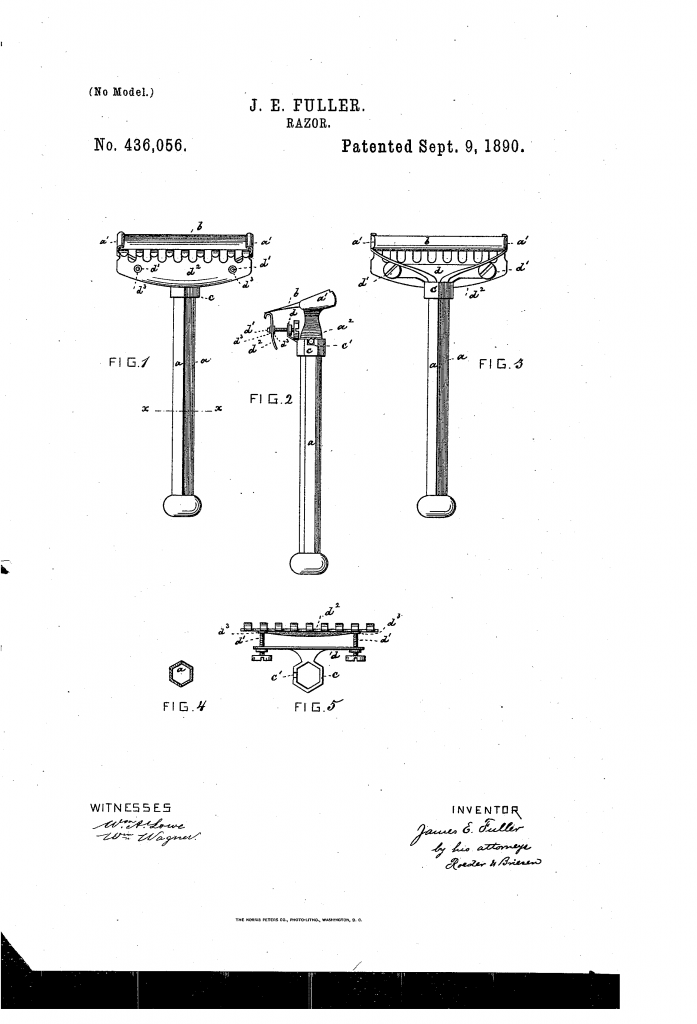When you think about the old wedge razors, adjustability is not the first thing you think about. But in 1890 Mr J E Fuller was granted a patent for a adjustable wedge razor. Additionally it had a novel way to hold the blade, one that would make taking the blade out for honing a lot less fiddly than some wedge razors out there.
I’ve talked about a wedge razors before, although none of them were adjustable. See, for instance, the razors patented by John Monk, the Kampfe brothers, and the late attempt by Bertil Åström.
J E Fuller’s patent
First things first though; the guard. Or comb, as we would say today.
There are a couple of ways to make a razor adjustable. One would increase the blade gap, that is the distance between the comb and the blade. Or you could change the blade angle, since a flatter blade tends to feel more aggressive. And one could change the expose, that is how much of the blade is ‘forward’ of the comb and cap.
Mr J E Fuller went for the last idea, although I have a feeling he didn’t set out to create an adjustable wedge razor per se – rather he wanted to make it easy to get the guard positioned just right.
Adjustability
A pair of small thumbscrew let the shaver move the comb back and forth. By positioning it forward, the razor would be milder. By moving it back towards the handle, it would be more aggressive. And by moving them differently, a slant-like effect might be achieved.1
In the words of the patent:
It will be seen that by turning the screws d in either direction the guard-plate is pushed either farther outward or farther inward. Thus it may be placed accurately beneath the cutting-edge of the blade. The advantage resulting from my construction is that the guard may be readily adjusted and without disturbing the blade.
J E Fuller, US Patent 436,056

Securing the blade
As for the novel way the blade was secured, the drawing and the text of the patent makes it easy to understand.
he letter a represents a split spring-handle connected at the bottom and separated at the top, where it is provided with the laterally-projecting arms a′, between which the blade b is held. Around the handle a there is slipped a slide c, to which the guard is secured. I prefer to make the handle and slide angular in cross-section, so that the latter cannot turn. The upward motion of the slide may be limited by a pin a2, projecting laterally from the handle and engaging a notch c′ in the slide. It is evident that when the slide is lowered the arms a′ will spread to release the blade, while when the slide is raised the arms will be drawn toward each other to lock the blade in place.
J E Fuller, US Patent 436,056
Or in less verbose form: The handle is in two halves, hinged at one end. At the other end are two claws, holding the blade. The ring holding the comb also locks the handle together, securing the blade. To remove blade, slide the comb holder down.
Thoughts on the razor
While Mr J E Fuller might not have intended to create one of the first adjustable razors I’m aware of, his razor should be considered to be a fully adjustable wedge razor. As for the applicability of this invention today… well, the idea of an adjustable comb might work on a modern single or double edge razor. It would require a lot of fine tuning and fiddly little thumb screws though. In the end, I suspect it wouldn’t be worth the effort.
Still, it is the earliest patent for an adjustable razor that I am aware of. That alone makes it interesting.
The full patent is available at Google Patents, as usual. And if you find old shaving patents and other oddities interesting, I still have a whole page of them.
Footnote:
- Or – more likely – the shaver could give himself some gnarly gashes.

Pingback: Another way to make an adjustable safety razor - Wegian WetshavingWegian Wetshaving